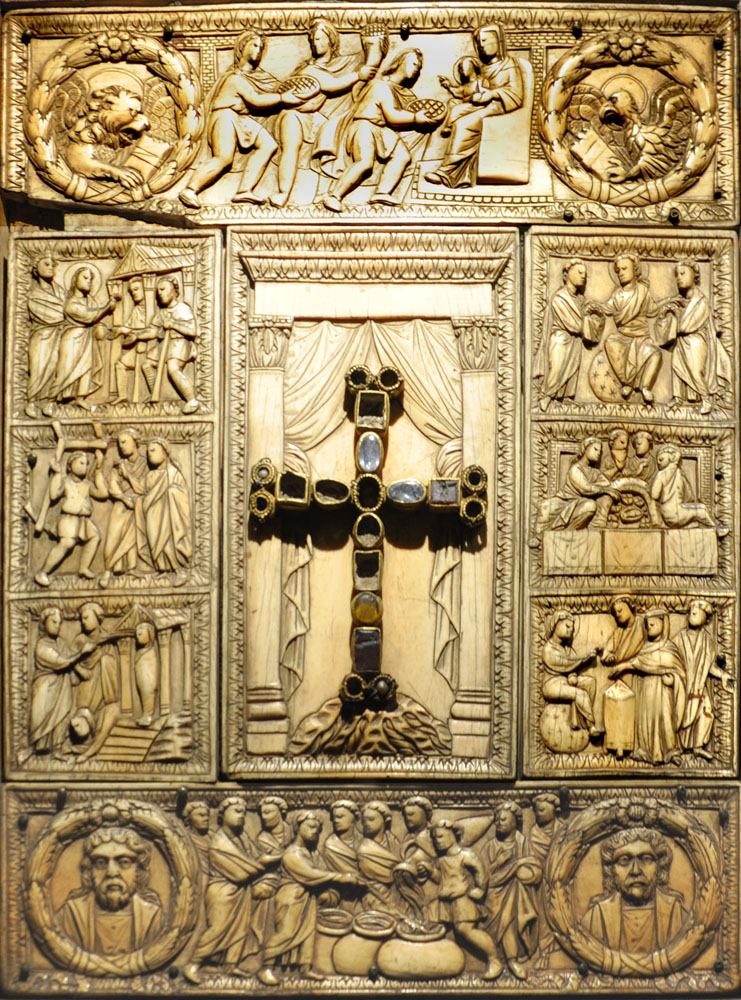
The Diptych of the Five Parts

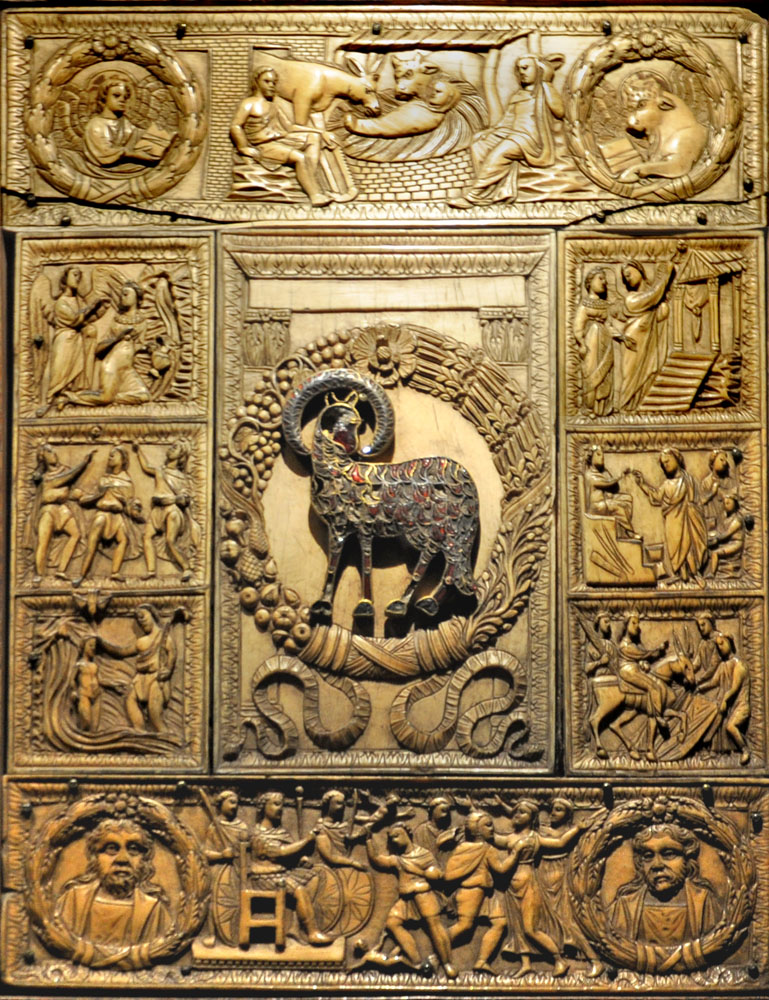
Ravenna, 5th century
Ivory Evangeliary cover
Museum of the Cathedral of Milan
Each side pictures two of the evangelists in the bottom tondos and their respective symbols in the top tondos, and each presents a symbol of Christ in the large central panel.
THE LEFT SIDE
The left side pictures Mark and John on the left and right, with the Adoration of the Magi at the top and the miracle at Cana in the bottom. The cross in the center stands on the hill of Calvary, but from it flow the four rivers of Paradise, a common motif in this era, especially in sarcophagi
(example).
The six small panels are arranged chronologically in a U-shaped pattern, going from top to bottom on the left and then from bottom to top on the right. Together they develop the theme that Christ is at the same time both fully human and fully divine, a doctrine that was defined by the Councils of Ephesus (431) and Chalcedon (451) but was a matter of serious dispute in 5th-century Ravenna.1 This theme is expressed in the miracles in the first three panels and in Jesus' seat "above the firmament" in the fourth and sixth.
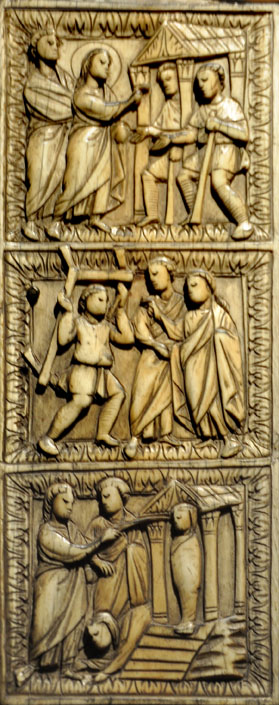 The first panel can be identified as Jesus' cure of the two blind men in Matthew 9:27-31, the only miracle in the gospels that involves precisely two supplicants. The two ask Jesus to "have mercy on us," a phrase often predicated of God in the Old Testament.2 Jesus responds by asking, "Do you believe that I can do this to you?" They do, and he cures them "according to your faith." In requesting "mercy" and affirming their faith, the blind men make clear their belief in Jesus' divinity.
The first panel can be identified as Jesus' cure of the two blind men in Matthew 9:27-31, the only miracle in the gospels that involves precisely two supplicants. The two ask Jesus to "have mercy on us," a phrase often predicated of God in the Old Testament.2 Jesus responds by asking, "Do you believe that I can do this to you?" They do, and he cures them "according to your faith." In requesting "mercy" and affirming their faith, the blind men make clear their belief in Jesus' divinity.
The middle panel treats another passage that reveals Jesus' divinity. The third man in the panel gestures as if introducing Jesus to the paralytic, so he is most likely one of the men who "brought to him one sick of the palsy" in Matthew 9:2. The scene cannot be taken from John 5, where a paralytic's problem is just that he has no one who will help him out. In Matthew, then, Jesus says, "be of good heart, son, thy sins are forgiven thee." Some bystanders object, because only God can forgive, but Jesus insists that "the Son of Man hath power on earth to forgive sins," and he proceeds to cure the paralytic and send him on his way. Jesus' insistence on his divine power is consistent with the orthodox position in the controversies of the day, which may explain the popularity of this episode in paleo-Christian art.3 The miracle was usually represented just as here, with the ex-paralytic carrying a bed frame while Jesus raises his hand in blessing.
In the bottom panel, the raising of Lazarus is the last of the miracles related in John's gospel (John 11:1-44). Like the preceding panel, this one follows what had already become a traditional way of picturing the event, with a wrapped-up Lazarus standing in a "tomb" that looks very much like a temple.
Read more about the blind men, the paralytic, and Lazarus.
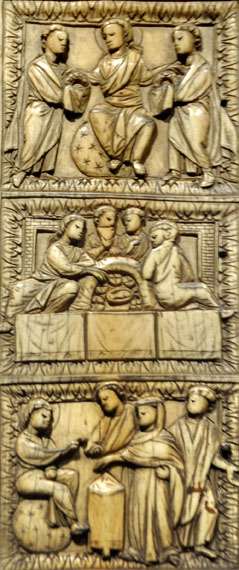 Now the pattern moves to the the bottom right panel. Christ sits on a starry orb, observing the scene of the "widow's mite" (Mark 12:41-42):
Now the pattern moves to the the bottom right panel. Christ sits on a starry orb, observing the scene of the "widow's mite" (Mark 12:41-42):
Jesus sitting over against the treasury, beheld how the people cast money into the treasury, and many that were rich cast in much. And there came a certain poor widow, and she cast in two mites, which make a farthing. And calling his disciples together, he saith to them: Amen I say to you, this poor widow hath cast in more than all they who have cast into the treasury.
In the panel the widow puts her two mites into a tall receptacle that represents the "treasury." The men behind her are probably some of the "many that were rich." (One might identify them as the disciples, but then why do they stand behind the widow rather than with Jesus?)
The orb in this context is highly significant. Jesus also sits on a starry orb in the top panel, presiding in Heaven. But here he sits in the Temple as a man "beholding" the people while at the same time judging them from his throne "above the firmament."4
The middle panel presents the Last Supper with round loaves marked with crosses and a "main course" of fish. The fish refers to Jesus' earlier miracle multiplying the loaves and fishes, which in John 6 he relates to the manna that fed the Israelites in the desert and to himself as "the bread of life." That metaphor is continued in the crosses on the loaves, symbols of his crucifixion.
At the top Christ sits on a starry globe as in the widow panel and hands martyr's wreaths to two disciples. The design adapts that of the traditio legis but with two young men instead of Peter and Paul. Conceivably the men could be some such pair as Cosmas and Damian or the deacon saints John and Paul, but more likely they are generic martyrs who have "run in the race" and received the prize.
See more about the widow's mite and the Last Supper.
THE RIGHT SIDE
On the right side of the diptych the rectangular panels at top and bottom picture the Nativity and the Slaughter of the Innocents. This pairing is found on other ivory plaques and sarcophagi of the time.5 In the Slaughter of the Innocents panel the soldiers are dashing the babies to the ground; in later images they almost always kill them with swords or spears. The Nativity image is like other paleo-Christian versions in that Mary is on the right and sitting down. Unusually, St. Joseph's status as a working man is emphasized by his simple tunic and the saw in his left hand that references his trade as a carpenter.
The evangelists represented are Matthew on the left and Mark on the right.
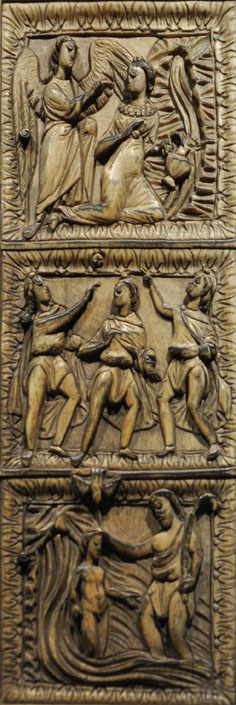 As on the left side, the six small panels are arranged chronologically in a U-shaped pattern. The first of them pictures the first episode in the Gospel of Pseudo-Matthew's Annunciation story. On the day before the actual Annunciation, Mary has gone to get a pitcher of water from a spring when she hears a voice that says, "Blessed art thou, Mary; for in thy womb thou hast prepared an habitation for the Lord." In the text she looks around but cannot see anyone; in this image her eyes point down and away, as if the angel were not visible to her.
As on the left side, the six small panels are arranged chronologically in a U-shaped pattern. The first of them pictures the first episode in the Gospel of Pseudo-Matthew's Annunciation story. On the day before the actual Annunciation, Mary has gone to get a pitcher of water from a spring when she hears a voice that says, "Blessed art thou, Mary; for in thy womb thou hast prepared an habitation for the Lord." In the text she looks around but cannot see anyone; in this image her eyes point down and away, as if the angel were not visible to her.
In the second panel the three Magi look to the star in the heavens that will guide them to the Christ ChildThey seem to be wearing Phrygian caps as they often do in other images of the time, but they are hard to make out; the dominant impression is of their long, wavy hair.
In the Baptism of Christ in the third panel, the River Jordan flows as a mirror image of the spring in the Annunciation panel. Schiller (133) surveys a number of paleo-Christian images that make the water flow from a rock, referring to the water miracles effected by Moses in Exodus 17 and by Peter in apocryphal texts. The dove dramatically breaks through the panel's frame to accompany the Father's words, "this is my beloved Son," another arrow in the quiver of orthodox theology. But Jesus is not only the son of God. Naked and exposing his pubic area to the viewer, he is also at the same time most assuredly a man.
Read more about the Annunciation, the Magi, and the Baptism of Christ.
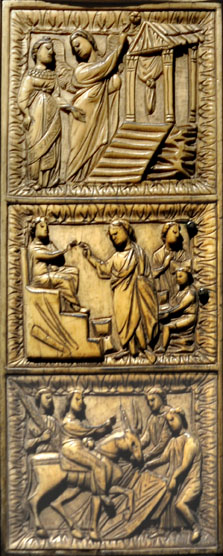 On the right the three panels follow in chronological order from bottom to top. First is Jesus' triumphal entry into Jerusalem. As he rides his ass toward the city, two men lay their cloaks on the ground before him. The man in the tree who will be an almost inevitable feature of later images is not yet in evidence.
On the right the three panels follow in chronological order from bottom to top. First is Jesus' triumphal entry into Jerusalem. As he rides his ass toward the city, two men lay their cloaks on the ground before him. The man in the tree who will be an almost inevitable feature of later images is not yet in evidence.
In the middle, Pilate on the left orders that Jesus be scourged and a soldier on the right puts a crown of thorns on his head. Schiller (I, plate 53) reads this panel as the episode of Christ among the Doctors (Luke 2:41-52) and calls the panel above it "unidentified scene." However, the scene above is rather clearly a Resurrection, completing a chronological sequence: Entry to Jerusalem – Passion – Resurrection. Besides, no one in Luke 2 puts a crown on anyone's head.
The panel at the top depicts an episode from the Resurrection narratives. An angel tells Mary Magdalene, "He is not here, for he is risen" and points to the empty tomb. (To the modern eye, the structure does not look like a tomb, but compare the tomb in the Lazarus panel, which is also pictured as a temple-like building with steps in front.)
Read more about the iconography of the entry into Jerusalem, the trial of Jesus, and the Resurrection.
Photographed at the museum by Richard Stracke, shared under Attribution-NonCommercial-ShareAlike license.